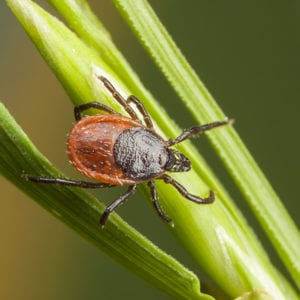 The Northeastern United States is known for being a tick utopia–and New Jersey is one of the top ten states for tick-borne disease cases! And ticks aren’t just a problem for humans; they’re a major health hazard for our beloved dogs and cats. While Lyme disease is pretty well known among most people, there are other, more complex diseases that can be transmitted to our pets via tick bite. Here in Holmdel, we want your four-legged family members to stay healthy, happy and safe. Because ticks are so small and sneaky, this makes them an even greater threat to your companion’s quality of life. But they don’t have to be! Read our prevention tips below, and call us at (732) 671-3110 if you have any questions.
The Northeastern United States is known for being a tick utopia–and New Jersey is one of the top ten states for tick-borne disease cases! And ticks aren’t just a problem for humans; they’re a major health hazard for our beloved dogs and cats. While Lyme disease is pretty well known among most people, there are other, more complex diseases that can be transmitted to our pets via tick bite. Here in Holmdel, we want your four-legged family members to stay healthy, happy and safe. Because ticks are so small and sneaky, this makes them an even greater threat to your companion’s quality of life. But they don’t have to be! Read our prevention tips below, and call us at (732) 671-3110 if you have any questions.
Ticks Commonly Found Here in Holmdel
Monmouth County is home to several tick species, and contrary to popular belief, most aren’t encountered out in the woods–they can be found right in your own backyard!
- Black legged deer tick
These ticks, named for their brown bodies and dark brown/black legs, are most often found in wooded areas and meadows of tall grasses and thick brush. They don’t wander far from their questing grounds. Black legged deer ticks are notorious carriers of the Borrelia burgdorferi bacteria, which causes Lyme disease in dogs and people.
- Lone star tick
Lone star ticks are considered aggressive; they will leave their questing areas to hang around on manicured lawns in search of a host. These critters can be identified by the single white spot on the back of their otherwise brown carapace. Lone star ticks can transmit ehrlichiosis, Rocky Mountain spotted fever, and tularemia (rabbit fever).
- Brown dog tick
Brown dog ticks are unique in that they are capable of infesting your home. They gravitate to cracks and crevices, are usually carried into the home by unsuspecting dogs. These ticks are capable of transmitting Rocky Mountain spotted fever to their canine hosts.
- American dog tick/wood tick
These ticks are very common in the area and are the ones you’re most likely to find on your pet. They can transmit Rocky Mountain spotted fever and tularemia.
What is “Questing?”
Questing is what ticks do when they’re on the prowl for a host. They can’t jump like fleas, and they don’t drop out of trees, either. Instead, they hang out on leaves, blades of grass, or other plants along tree and grass lines–areas where animals and people tend to pass by frequently. When they sense the vibrations of an approaching prospect, the tick will climb up to the edge of their perch and reach out with their front legs. If they’re lucky, they’ll be able to attach themselves to their host as it’s brushing past.
Tick-Borne Diseases that Affect Pets
What makes ticks particularly dangerous are the diseases they can spread to pets (and sometimes people). Below are the most common and their symptoms.
Lyme Disease in Dogs
- Painful, swollen joints
- Lameness
- Fever
- Lack of appetite
- Lethargy
Rocky Mountain Spotted Fever
- Fever
- Lameness
- Lack of appetite
- Muscle and joint pain
- Coughing
- Vomiting
- Diarrhea
Ehrlichiosis
- Fever
- Lethargy
- Lack of appetite
- Swollen lymph nodes
- Neurologic issues
Tularemia
Tularemia, also known as rabbit fever, is somewhat rare, but infection is possible among domestic animals. Clinical signs present differently in cats and dogs, with the disease being more fatal in cats.
Dogs
- Fever
- Nasal discharge
- Loss of appetite
- Enlarged lymph nodes
Cats
- Fever
- Depression
- Enlarged lymph nodes
- Abscesses
- Diarrhea
- Loss of appetite
- Weight loss
- Pneumonia
- Sepsis
How to Prevent Tick Bites and the Spread of Disease
Ticks are a menace, but they’re not an unbeatable foe. A little mindfulness and high-quality tick prevention for dogs and cats will go a long way towards keeping your pets–and your home–parasite-free.
Here are some of the most helpful things you can do to combat ticks:
- Make sure to give your dog or cat their monthly flea and tick preventative, all year round
- Before bringing your pet in from outside, check them over for ticks–their coat, inside their ears, between their paw pads, under their tail–everywhere (and check yourself, too!)
- Keep your lawn well trimmed and don’t leave leaf litter, wood piles, or thick brush too close to the house
- Avoid walking your pet through tall grasses and thickly wooded areas; keep to clear paths
- If Lyme is prevalent, ask about getting the Lyme vaccine for your dog
How to Remove a Tick
Removing a tick from your pet is not as easy as simply brushing it off. Ticks embed their mouth parts under the skin to feed, and these mouth parts can be left behind if you try to pull the tick out too quickly.
Here are the steps for a successful tick removal:
- If possible, get a friend or family member to hold your pet still
- Take a clean pair of tweezers and place them around the tick and as close to your pet’s skin as possible
- Gently grasp the tick and slowly pull it upwards with the tweezers
- Check to make sure you have removed the entire tick, mouth parts and all
- Place the tick in a sealable plastic baggie
- Wash the bite area with warm, soapy water
- Wash your hands and clean the tweezers
- Call your veterinarian for tips on what to do next
With the right preventive measures and understanding of how ticks “tick,” your pet, your home, and the rest of your family can stay well protected against these pests and the diseases they might be carrying.
